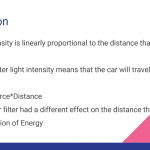Project By: Bobby Garces, Christopher Rabelo, Mandar Patel, Julius Hahr
Objective:
- Investigate the law Work = Force*Displacement
- Investigate how different color filters affect the car’s motion
Procedure:
- Place the color filter of your choice on the solar powered car (tape will help).
- Place the solar powered car at a starting location of your choice and hold it in place.
- Place the light source a set distance directly overhead the toy powered car
- Release the toy car, without moving the light source at all. Record the distance travelled by the car.
- Collect a total of 3 trials per color filter in order to minimize error from outliers and other factors
- Repeat steps 2 thru 5 for each color filter.
- Finally, using the NXT and the light intensity sensor, place each color filter over the sensor and place it the same distance away from the light source as the height above the car you placed the source during the experiment.
| Color | Light Intensity (klx) | Distance 1 | Distance 2 | Distance 3 | Average Distance |
Post Experiment Questions:
What relationship did you find between the light intensity and distance the car traveled?
How did the colors filters affect the distance? Any relationship between color and distance?
My group and I went to two different high schools to make presentations. The first we went to was the John D O’Bryant High School. At first I was admittedly nervous because I did not know what to expect from the students at this school. From what I had been told it was an engineering/physics class. So I was afraid to present something that I didn’t believe to me that complicated to students who might have already done the work I have done. But at the end I was glad they knew so much, even for 9th graders. The presentation itself went by normally, everyone presented their parts, we showed off the solar cars, and gave our conclusions on the presentation. The best part came afterwards. The students were very interested in the projects and asked many good and thoughtful questions. For such young faces to throw question after question to me and my partners, it made my whole experience very worthwhile knowing I had peaked interest in many of these students. Actually conducting the experiment with them was even better because of even though I asked some of the students if they were interested into going into engineering and hearing “No”s as answers, they were still involved and interested in my project. They liked learning how light can make a car, even a very small one, move. There was one student, unfortunately I never got his name, that was very involved and kept asking me question and wanted to help hold the light source, place the car, all of that. Getting at least one student interested to that level was exciting. I didn’t expect the students to be that interested in what I have to say, when I was in high school, especially that young, I just wanted to get out of class. But all these kids at the O’Bryant restored my faith in the younger generation.
I won’t say much cause there really isn’t much to say, but going to Charlestown High school was a big disappointment. I presented by myself to I think it was 3 kids, who I doubt payed any attention to what I had to say. Compared to going to the O’Bryant, Charlestown high school was a complete waste of time. I know it was not Dr. Shatz fault, she expected a larger crowd as well. We were all let down by that school, so much though that not all of us even presented.
Overall I had a great time with the experiment, and hope to be able to travel to high schools in the future and be able to influence future high school students to pursue a career in engineering.








